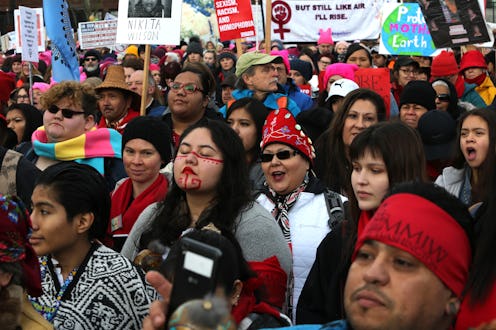News
This Report On Murdered Or Missing Native American Women Is Beyond Alarming

Native women experience staggering rates of murder, sexual assault, and domestic violence, and yet the data and reporting on crimes against them is woefully inadequate. A new study from the Urban Indian Health Institute (UIHI) attempts to quantify the number of Native American women murdered or missing, and document how the criminal justice system lets them down along the way.
Two UIHI researchers named Abigail Echo-Hawk and Annita Lucchesi surveyed 71 cities across America and found that almost 60 percent of the police departments they contacted either didn't return their requests, or provided flawed or incomplete data. The report says that of the 5,712 cases of missing indigenous women and girls reported in 2016 alone, only 116 (2 percent) were ever logged in the U.S. Department of Justice missing persons database.
Echo-Hawk and Lucchesi identified 506 unique cases of missing or murdered indigenous women registered with law enforcement in their study, but said that that number was likely much higher, in part due to the way in which the data is being collected in cities.
"Our women and our children, our girls, they hold such value within our communities," Echo-Hawk told HuffPost about the motivation for the project. "For us to let their deaths to just go unnoticed — for people not to know that we have missing women in our communities, for their voices not to be heard — to me was unacceptable."
Murder rates for indigenous women living on tribal land are extremely high — a DOJ study estimated it was more than 10 times the national average. But Echo-Hawk's and Lucchesi's research focuses primarily on urban native women, since a majority of America's native population lives in cities.
"So much of the conversation on this issue has been focused on reservations," Lucchesi told NPR. "This is happening to our urban women too. It isn't just a matter of jurisdiction — it's a matter of racism."
Of the cases they surveyed, 128 were for missing women, 280 were for murdered women, and 98 held an "unknown" status. In 96 instances, the case was in some way connected to "broader issues such as domestic violence, sexual assault, police brutality, and lack of safety for sex workers."
Just as central to the study as the data itself were the challenges that Echo-Hawk and Lucchesi faced in trying to obtain case records. They reported that nine of the 71 cities said they were not able to identify Native American victims in their database, even though race is generally a classifier when crimes are documented. Others, they said, misclassified native women, or didn't identify them as native at all, especially in cases where their tribe was not federally recognized.
And that documentation issue extends to the media as well. Echo-Hawk and Lucchesi pored through articles in the area and time frame of the 506 women and found that 95 percent of their cases were never picked up by any news outlet. Of the coverage they surveyed, they found that 31 percent of the outlets covering missing and murdered indigenous women used what they called "violent language," which they defined as including, among other things, racial stereotyping, misogyny, victim-blaming, misgendering transgender victims, and harmful references to drugs, alcohol, sex work, and criminal history.
"The 506 are just the ones we know about ... it's just the beginning, it's barely scratched the surface," Echo-Hawk told NPR. "I know that there are hundreds, thousands and more that aren't in this data and haven't been captured."